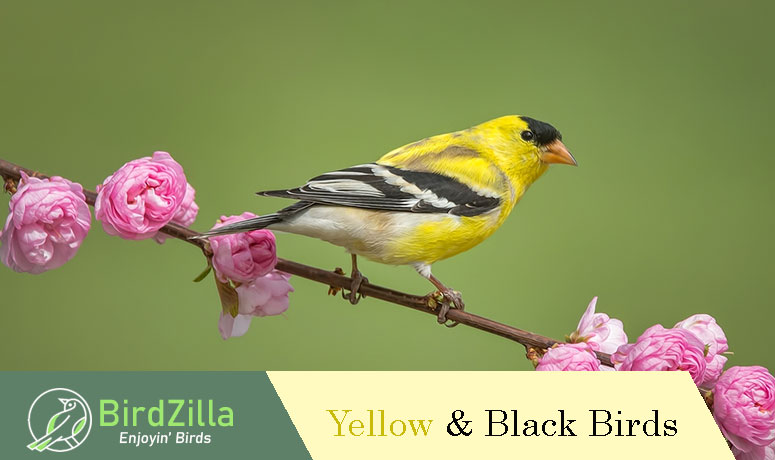
The color of a bird’s plumage is critical not only because birders use markings and colors to identify birds but also because birds have incredible color vision.
Yellow and black birds are not too uncommon, but they are still a sight to see!
We’ve compiled a list of the most common yellow and black birds some of you may be familiar with and others you may not be. Some of these birds may be primarily yellow, while others may be almost completely black with sections of yellow.
On this page
#13 Common Yellowthroat
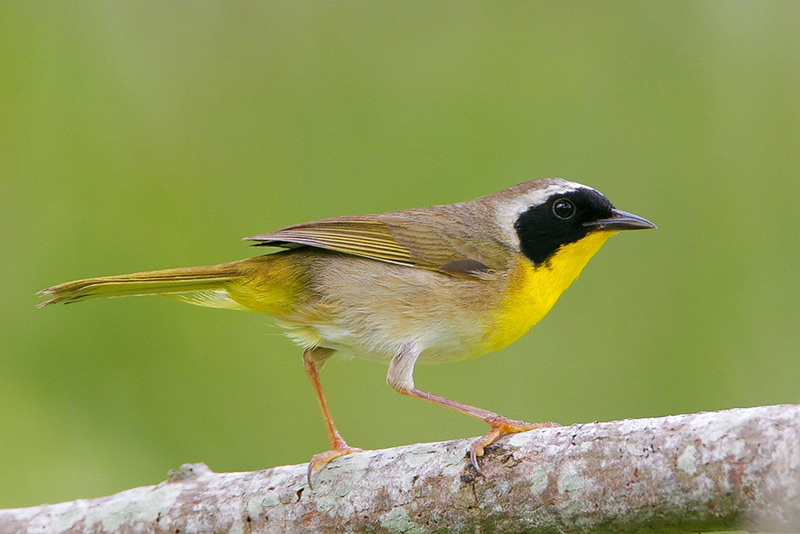
Photograph © Greg Lavaty.
Adult male Common Yellowthroats have olive upperparts, bold black face masks, and bright yellow below. A thin white line contrasts the black mask from the neck to the head. Immature males have a small portion of the black mask adult males have.
Common Yellowthroats live in tangled, thick vegetation in a wide range of areas. This includes pine forests, parries, and wetlands across North America.
Their breeding range stretches across western Mexico, Canadian provinces, and most of the U.S. Common Yellowthroats are most common in moist areas, which tend to have thick vegetation that’s low to the ground.
However, these birds can also be found in palmetto thickets, disturbed sites, dry upland pine forests, drainage ditches, orchards, hedgerows, river edges, fields, and burned-over oak forests.
- During the breeding season, males perform displays to attract a mate, and females tend to prefer males with larger face masks.
- The Common Yellowthroat was one of the first birds to be cataloged from the New World.
- There are 13 confirmed races of the Common Yellowthroat. The main differences are the brightness of the yellow underparts and the facial patterns of the males.
#12 Magnolia Warbler
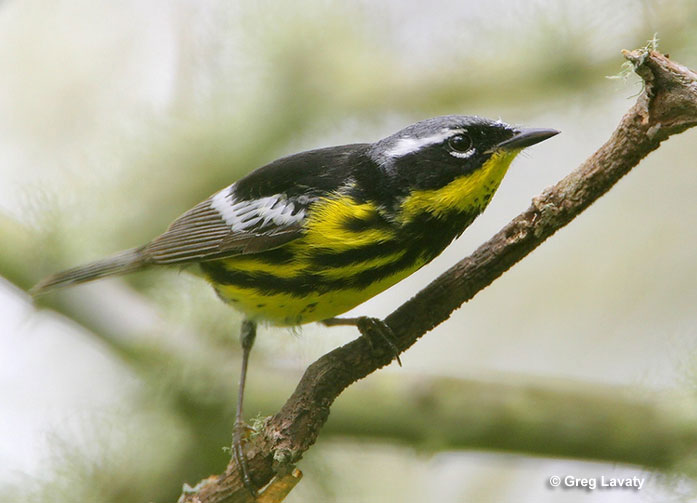
Adult male Magnolia Warblers have distinct black streaking, black masks, broad white wing patches, a yellow belly, and throat, and are gray and black above. Additionally, they have a unique tail pattern; black at the tip and white at the base.
Magnolia Warblers breed in dense, young conifer trees, especially hemlock in the south and spruce in the north. When migrating, these birds forage in dense areas along parks, woodlots, and forest edges.
On their wintering grounds, these birds inhabit areas from sea level to 5,000 feet, including thickets, forests, orchards, and cacao plantations.
- The oldest Magnolia Warbler lived to be at least 8 years and 11 months old. It was a male, and he was initially banded in 2005 in Ontario. He was recaptured and rereleased in 2013 in the same area.
- On their wintering grounds, these birds inhabit areas from sea level to 5,000 feet, including thickets, forests, orchards, and cacao plantations.
- Male Magnolia Warblers have 2 songs. The first song is used around the nest and for courtship. The second song is issued for territory defense.
#11 Evening Grosbeak
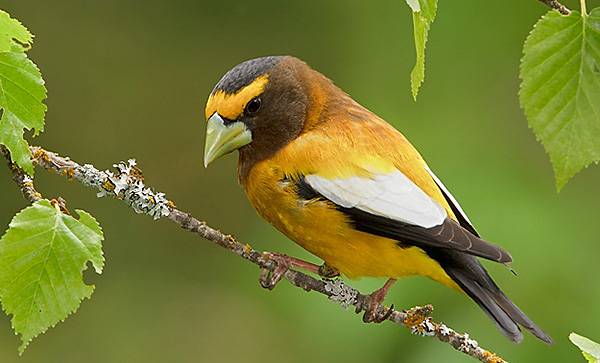
Photograph © Glenn Bartley.
Male Evening Grosbeaks have bold white patches on the wings, bright yellow stripes over their eyes, and dark heads. Additionally, their bill is pale ivory.
These birds breed in second-growth and mature coniferous forests of the northern portions of North America and the Rocky Mountains, including pine-oak, spruce-fir, aspen forests, and pinyon-juniper.
Less commonly, they nest in orchards, parks, and deciduous woodlands. They breed as far south as Mexico at 5,000 to 10,000 feet in pine-oak and pine woodlands.
- Evening Grosbeaks have very large bills. They can crush seeds that are too large for even Pine Siskins and Common Redpolls to open. These birds are smaller and often look for grosbeaks and grab the food scraps they leave behind.
- Evening Grosbeaks are non-aggressive and friendly to those in their species.
- The oldest Evening Grosbeak lived to be at least 16 years and 3 months old. It was a male who was rebanded in 1974 in New Brunswick. He was initially banded in 1959 in Connecticut.
#10 Prothonotary Warbler
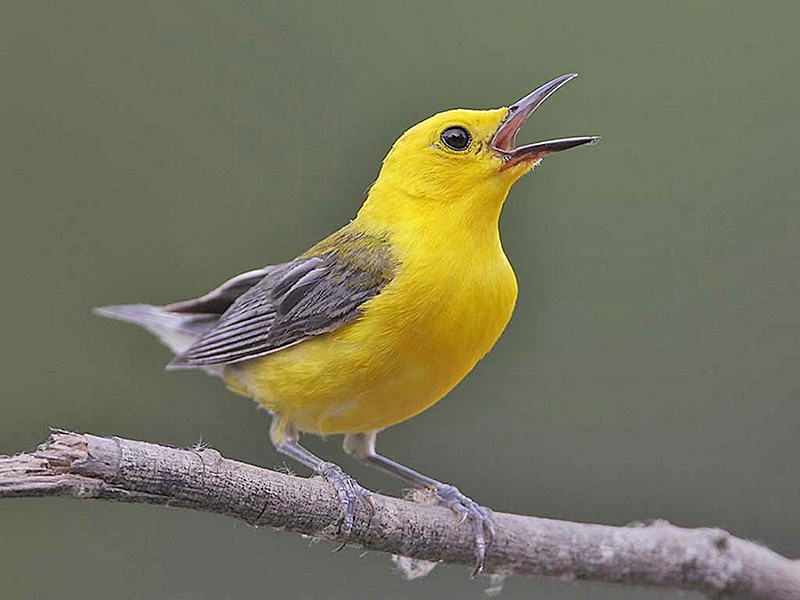
Photograph © Greg Lavaty.
Prothonotary Warbler is a small warbler with yellow and dark gray plumage. Although their wings are grayish in color, they can appear to have yellow and black plumage in certain lighting.
Females and males look similar, but male Prothonotary Warblers tend to have brighter plumage and a stockier build.
#9 Western Meadowlark
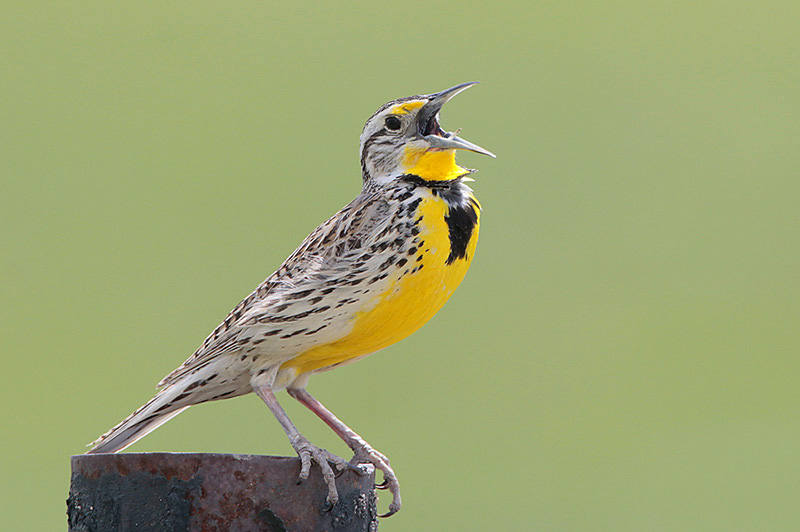
Western Meadowlarks have a black V across their breast, bright-yellow breasts, buff and black upperparts, and contrasting stripes of light buff and dark brown on the head. When in flight, the white outer tail feather can be seen.
Related: Birds with yellow bellies
Western Meadowlarks live in agricultural fields, prairies, open grasslands, and meadows from sea level to 10,000 feet. These birds avoid wooded areas and edges with heavy shrubbery.
In the winter months, they forage for seeds on the ground.
- Western Meadowlark nests usually have a partial grass roof. However, their nests can vary greatly. Some may have a full roof and entrance tunnels, while others may be completely open.
- Western Meadowlarks are not common in backyards. However, they’ll sometimes visit yards in agricultural, rural areas. You can make your backyard more attractive to them by providing grass seeds, open areas, and ample perching spots.
- A male Western Meadowlark can have two mates at the same time. The females are the ones who incubate and brood and, most of the time, feed their young.
#8 Yellow-Headed Blackbird
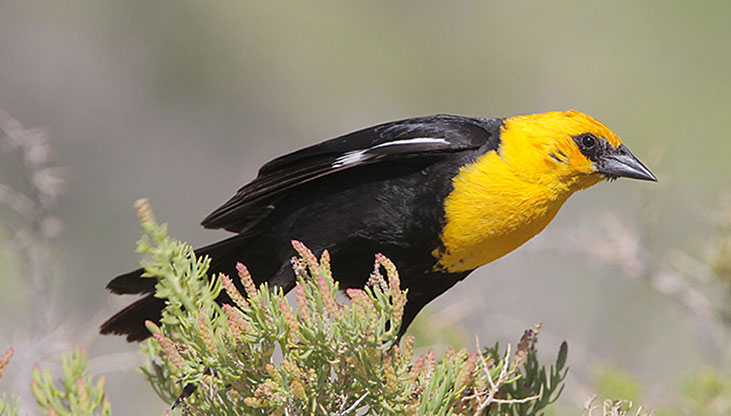
Male Yellow-headed Blackbirds are striking with their yellow chests and heads. Additionally, they’re black overall and have obvious white wing patches. Immature and female birds are brown instead of black and have paler yellow heads.
These birds breed in prairies, wetlands, mountain meadows, rivers, quaking aspen parklands, ponds, and marshes. Additionally, they nest in reeds, bulrushes, and cattails. They’ll sometimes move to surrounding croplands, savanna, or grasslands to forage for food.
In the winter months, Yellow-headed Blackbirds come together in the thousands into large flocks and forage in farmyards, ranchlands, and crop fields from New Mexico, Texas, and Arizona through Mexico.
- The oldest recorded Yellow-headed Blackbird lived to be at least 11 years and 8 months old. It was banded in 1983 in Saskatchewan and was found in 1955 in Nebraska.
- Yellow-headed blackbirds are insectivores and granivores. They mainly eat insects and seeds. They specialize in aquatic prey, especially dragonflies, damselflies, and insects.
- The scientific name for Yellow-headed Blackbirds is Xanthocephalus, which means “yellow head.”
#7 Hooded Warbler
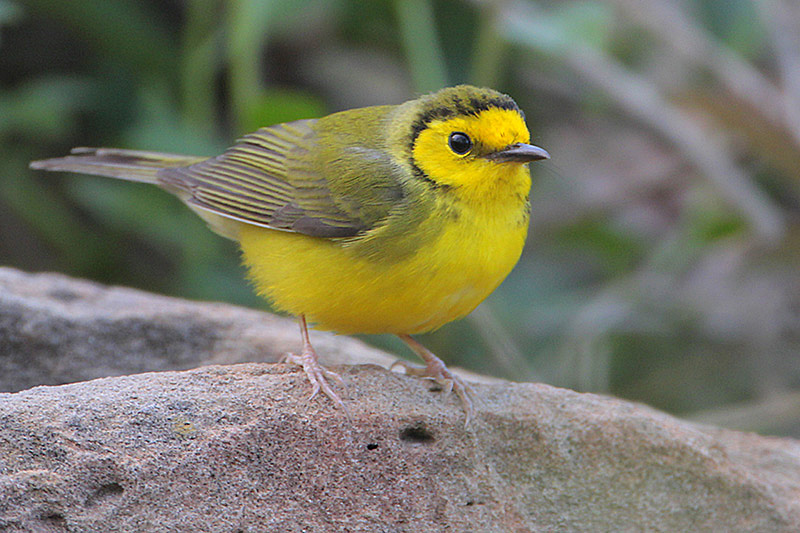
Photograph © Greg Lavaty.
Adult male Hooded Warblers have yellow cheeks, a yellow forehead, a black throat, and a hood, are bright yellow chest and belly, and are olive-green above. Immature and female birds are also yellow below and olive-green above but don’t have the black hood.
Hooded Warblers breed in fully grown deciduous forests with a dense understory of rhododendron, mountain laurel, spicebush, and viburnum up to 3,600 feet.
These birds spend their winters in lowland scrub, brushy fields, and tropical forests.
- Hooded Warblers fan their tails often, showing off their white outer tail feathers.
- Both female and male Hooded Warblers are very territorial on their wintering grounds. Females are found in seasonally flooded areas and scrubby forests, while males are found in fully-grown forests.
- Hooded Warblers have large eyes in proportion to the rest of their bodies compared to other warblers. This could be because they prefer shady undergrowth.
#6 Eastern Meadowlark
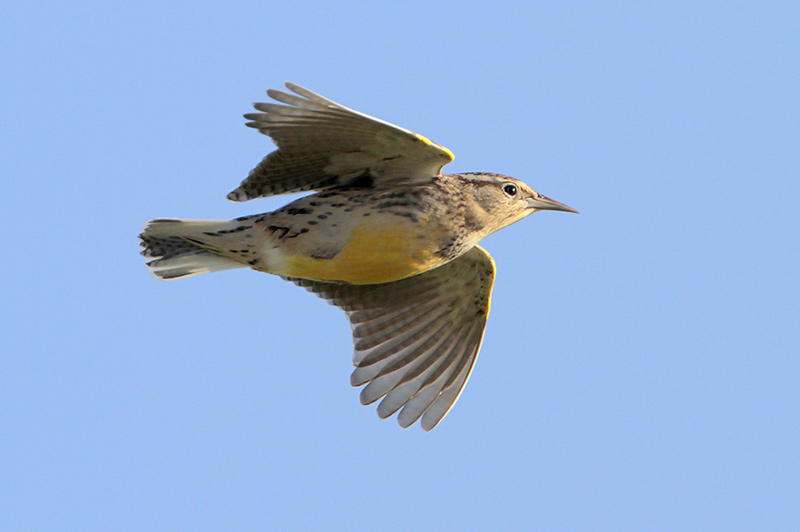
Photograph © Greg Lavaty.
Eastern Meadowlarks have a black V across their chest, bright-yellow underparts, and are pale brown overall. Most of their tail is brown, and they have blackish barring. Additionally, their outer feathers are white and obvious during flight.
Eastern Meadowlarks are most common in native prairies and grasslands. However, they also inhabit hayfields, pastures, airports, and agricultural fields.
Large areas of grasslands are hard to find in the eastern portions of North America; because of this, Eastern Meadowlarks will breed in many kinds of grassy habitats as long as they can find around 6 acres of territory.
- Western and Eastern Meadowlarks are nearly identical, but these birds almost never hybridize. Mixed pairs really only occur at the edge of the range when few mates are available.
- Eastern meadowlarks like to bathe in wet grass and puddles on hot summer days.
- The Eastern Meadowlark is not part of the Lark family. It’s a member of the Blackbird family, including orioles and cowbirds.
#5 Lesser Goldfinch
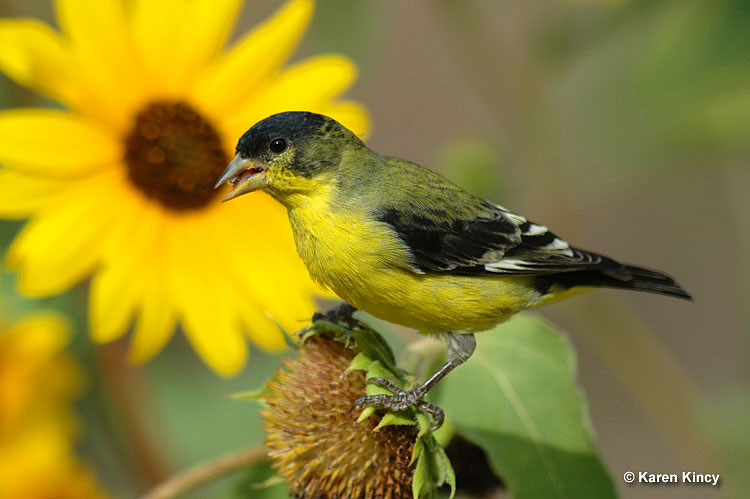
Male Lesser Goldfinches have white wing patches, glossy black caps, and are bright yellow below. Their backs can be dull green or glossy black, and they have black tails with large, white corners. Immature and female birds have black wings with white wing bars, pale yellow underparts, and olive backs.
The Lesser Goldfinch inhabits patchy open habitats. From South America to the Western U.S., these birds frequent weedy fields, thickets, desert oases, woodlands, scrublands, forest clearings, and farmlands.
You can also find these birds in gardens and parks. Some common habitats in the western U.S. include pinyon-juniper, oak, cottonwood, cedar, willow, chaparral, and pine woodlands.
- The oldest recorded, Lesser Goldfinch, lived to be at least seven years old. It was a male who was recaptured and rereleased during banding operations in 2015 in California.
- The Lesser Goldfinch is also known as the Dark-Backed Goldfinch.
- Lesser Goldfinches are the most abundant in Texas and California, with local population pockets throughout the rest of its range in the United States.
#4 Scott’s Oriole
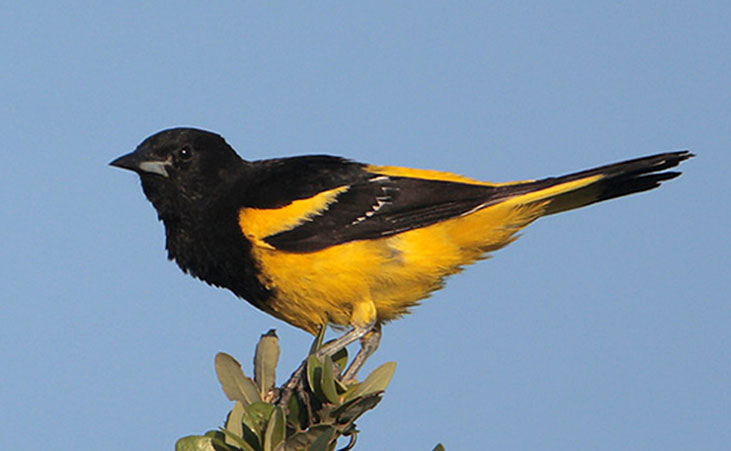
Adult male Scott’s Orioles are black above, vivid yellow below, and have a black chest and throat. In addition, they have a black-and-yellow tail, yellow shoulder, and white wing bars. Immature males, birds that are a year old, are a mix of adult females and males. They have a black upper breast, throat, and face.
Scott’s Orioles inhabit mountains, deserts, and arid foothills. However, they rarely nest in low deserts that are cactus-dominated.
Instead, they prefer higher slopes with abundant live oak, yucca, juniper, pinyon pine, and agave. At lower elevations, these birds usually nest in desert oases with tall trees, including Joshua trees and palms.
In southwestern Mexico, Scott’s Orioles inhabit similar places but also occur in both dry and humid pine and pine-oak woodlands and cactus-acacia-mesquite grasslands.
Scott’s Orioles nest in plants including candlewood, yuccas, olive, elder, orange, mango, and palo verde, as well as various species of sycamore, cottonwood, and mesquite.
- Scott’s Oriole was named after General Winfield Scott, a Civil War Union Army General.
- Scott’s Oriole is one of the first birds to start singing every day; they begin singing before sunrise. These birds are also persistent singers. They can be heard throughout most of the summer at all times of the day.
- The Scott’s Oriole prefers dry plains and desert hillsides. This is especially true if yucca plants are available near water. These birds find the majority of their food supply in the yucca plants.
#3 Female Orchard Oriole
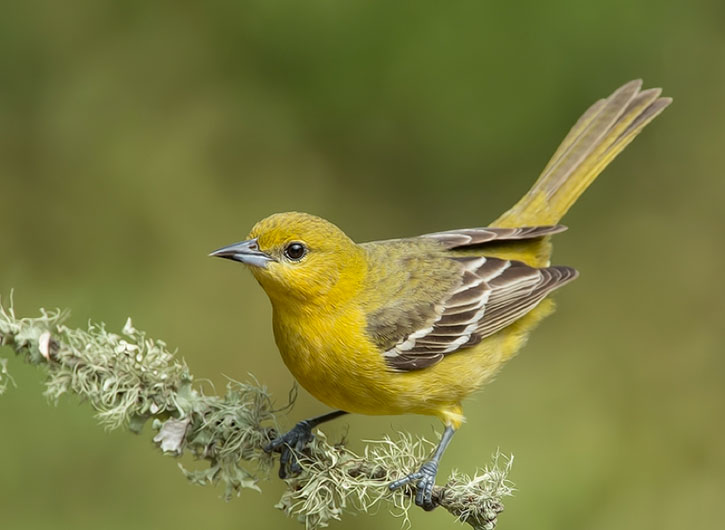
Photograph © Alan Wilson.
Female Orchard Orioles look very different from breeding male Orchard Orioles. They have two white wing bars, are greenish yellow overall, and their wings are light black. As a result, it’s not uncommon for female Orchard Orioles to be mistaken for American Goldfinches.
Orchard Orioles can be found along river edges in open woodlands, lakeshores, marsh edges, farms, and open shrublands. In open habitats, they nest in scattered trees.
Orchard Orioles winter in tropical forest edges, thickets, plantations, lightly wooded areas, and shady pastures.
- The Orchard Oriole is the smallest oriole in North America. They’re often confused for warblers because of their bright color and small size.
- Orchard Orioles won’t visit backyard bird feeders. However, you can attract them to your yard with fruit jelly, sliced oranges, and hummingbird feeders. Since these birds are also insectivores, a backyard with shrubs may provide enough spiders and insects to attract them.
- Orchard Orioles are not aggressive birds; they tolerate each other and other bird species. These birds nest in close quarters with Bullock’s Orioles, Baltimore Orioles, Chipping Sparrows, Eastern Kingbirds, American Robins, Western Kingbirds, and Chipping Sparrows.
#2 Western Tanager
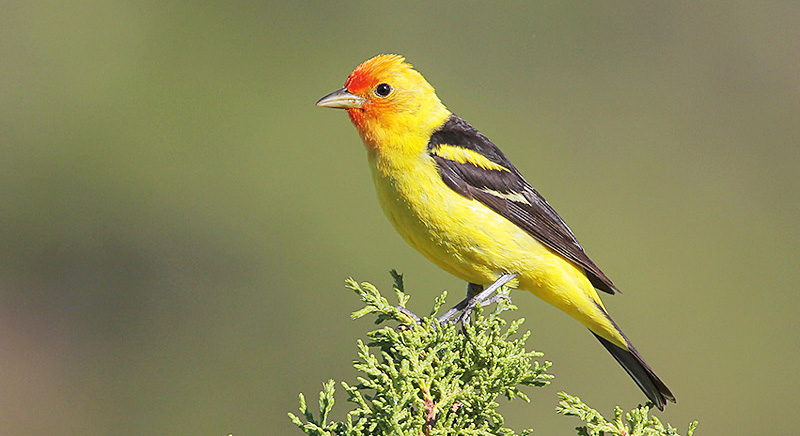
Adult male Western Tanagers have a flaming orange-red head, black wings, and an overall yellow body. Additionally, their wings have two strong wing bars; the lower one is white, and the upper one is yellow. Their tail and back are black.
Western Tanagers can be found in lodgepole pine, ponderosa pine, and Douglas-fir forests. They breed in oak and pinyon-juniper woodlands, aspen forests, and riparian woodlands.
They usually favor open woods, including forest edges, suburban parks, wetlands, and gardens.
- The oldest recorded Western Tanager lived to be at least 6 years and 11 months old. It was a male who was initially banded in 1965 in Nevada. He was recaptured and rereleased during banding operations in 1971 in Oregon.
- Western Tanagers migrate farther north than any other Tanager. They’ve been recorded traveling as far as Yukon, Canada.
- The Western Tanager gets its red head feathers from rhodoxanthin, which is a rare pigment. Birds cannot make this pigment naturally; it’s theorized that Western Tanagers obtain it from the insects they consume.
#1 American Goldfinch
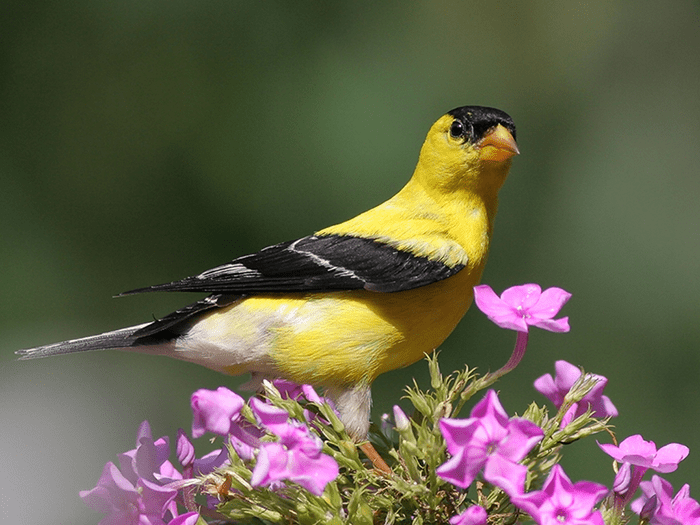
Male American Goldfinch
Adult male American Goldfinches are bright yellow and black birds. In the winter, they’re duller, unstreaked brown, and have blackish wings with two dull wing bars.
Adult female American Goldfinches look very different from breeding male American Goldfinches. They’re olive above and pale yellow below. Winter birds are dull as well and are unstreaked brown. Their wings are blackish with two faint wing bars.
This (mostly) black bird with yellow bill inhabits open floodplains, weedy fields, and other overgrown areas that have some trees and shrubs for nesting and thistle, sunflower, and aster plants for food. American Goldfinches are also commonly seen in backyards, parks, and suburbs.
- The oldest recorded American Goldfinch lived to be at least 10 years and 9 months old. It was initially captured during banding operations and recaptured and rereleased in Maryland during additional banding operations.
- American Goldfinches are one of the most strict vegetarian bird species; they opt for a completely vegetable diet and only accidentally swallow an insect occasionally.
- The American Goldfinch is the state bird of Washington, Iowa, and New Jersey. In Iowa and New Jersey, it’s called the “eastern goldfinch.” In Washington, it’s called the “willow goldfinch.”

